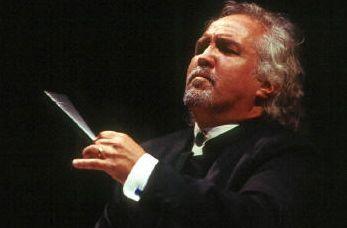by Paul J. Pelkonen

Your Valkyrie Airlines flight director: conductor Donald Runnicles.
Photo by Ken Friedman © San Francisco Opera.
The Beethoven opened the program, with Mr. Vogt displaying his precise, pedal-heavy approach to this music. Mr. Runnicles drove the accompaniment forward, reveling in the lush strings and winds that characterize the "Philly sound." Mr. Vogt too, seemed comfortable in his approach to the solo part, playing with a warm, singing tone and an appreciation for the robust humor that infects this early work. Especially impressive, the tricky cadenzas of the third movement, answered back by robust tone from the orchestra.
Mr. Runnicles returned to start the Wagner excerpts with the Ride of the Valkyries, that Act III curtain-raiser from Die Walküre beloved of Army colonels and a certain, magic helmet wearing rabbit-hunter. Although the early horn-calls featured a few false notes at the top of the phrase, the players settled in to create the illusion of soaring flight and wild warrior women without the aid of sopranos, costumes, or rising and falling planks. The cellos were particularly fine here, supplying the tricky "horse" rhythms that are the engines of this piece.
The conductor then picked up a convenient microphone to address the audience. He explained that when Wagner first composed the operas, he also created these orchestral arrangements as a way to get the music heard away from his opera house in Bayreuth. Mr. Runnicles then added that the next pieces on the program included the Forest Murmurs from Act II of Siegfried, and then three long sections extracted from the pages of Götterdämmerung.
The Forest Murmurs had a glowing, transparent sound, with warm rich bowing from the cellos answered by the tweets and twitters of flute, English horn and clarinet. The excerpt was in two sections, played seamlessly together to neatly omit the brief brawl between Siegfried and the dragon Fafnir, a section of the opera that many Wagnerians might wish to skip in the theater. Even without the dragon, Mr. Runnicles sped the tempo to create the sound of a hungry young man racing off into the wilderness to woo Brunnhilde, the fabulous bride (and Valkyrie) sleeping on a nearby mountaintop.
Ensemble and maestro collaborated to create a Dawn and Rhine Journey that illustrated Wagner's art of transition. This music starts with low, muttering lines for the basses. These slowly give way to ascending horn calls and a low, mellifluous melody on the bass clarinet. The great crescendo was played with a lightness of texture and power that showed the muscle underneath Wagner's orchestral excess, and the brilliant economy of phrase. The Rhine Journey was even better, with harps, percussion and brass getting in to describe the trip through the Magic Fire, the swelling rushing river itself, and ultimately the evil of the ring and the plotters awaiting Siegfried's arrival in the next scene.
The concert ended with two excerpts from the last act of Götterdämmerung depicting the climactic events of the cycle in purely orchestral terms. Unusually, Mr. Runnicles chose to start from a few minutes before the Funeral Music, including the harsh, dark chords that depict the murder of Siegfried and the reprise of music from earlier in the cycle that evokes his final thoughts of Brunnhilde. From there, the orchestra went headlong into the funeral march, played to mournful, stirring effect. After this massive funeral, the beauties of the Immolation Scene seemed almost anti-climactic, especially given the absence of a soprano to sing that famous death scene.

